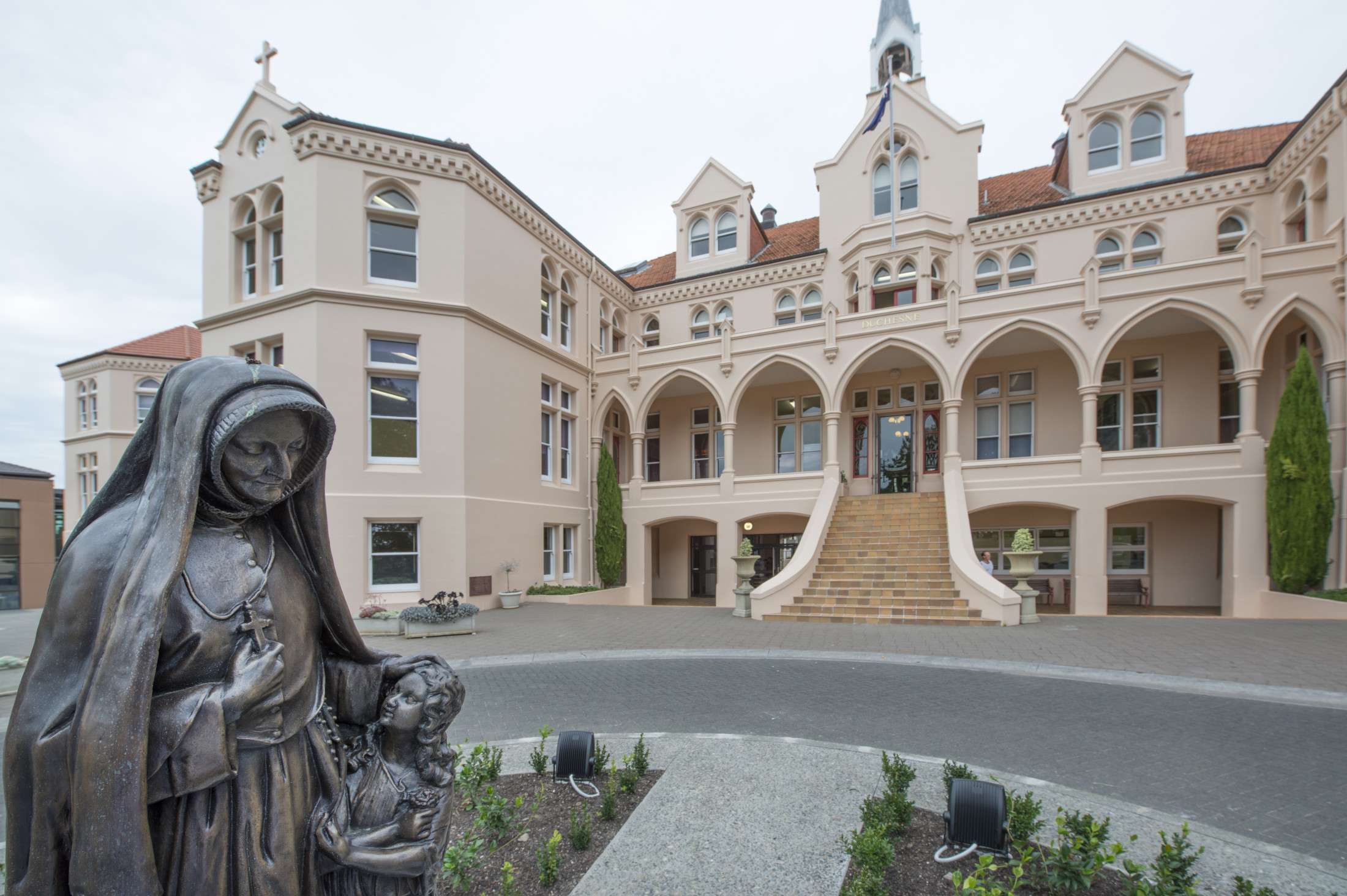She was a delicate little girl, spoilt, bubbling over with life and intelligence. Born during the night of 13 December 1779 in the little Burgundian town of Joigny in the glimmer from a neighbour's burning house, she was premature and so frail that she was baptised at dawn. She was the third child in a family of craftsmen, barrel-makers and vine-growers, who lived comfortably enough in a small house in the rue du Puits-Chardon (today, 11 rue Davier). When she was seven, she became the pupil of her brother Louis, eleven years her senior. He was teaching in the local college until he was old enough to be able to be ordained priest. Under his austere direction she made astonishing progress in all her subjects, both secular and religious; yet she regretted hardly having time to play with friends her own age, even at the time of the grape harvest and traditional holiday in the country of vineyards! Her family's jansenistic severity might have crushed and destroyed her, but fortunately she kept her spontaneous vivacity and joyful character.
During the Revolution Sophie was a courageous adolescent. She, who so loved study had to work as a seamstress and became an excellent embroidress. She had to be the link between her father, a good workman but illiterate, and her mother, more refined, sensitive and cultured. Above all she had to sustain the courage of her family when her brother was made prisoner by the revolutionaries and only escaped the guillotine by the intervention of providence. It was then that Sophie discovered devotion to the Sacred Heart and that she put all her trust in the love of Christ.
Still very young, she gave proof of resolve and generosity when her brother, liberated by the fall of Robespierre, asked her to come to Paris to continue her education. Certainly it cost her dearly to tear herself away from her mother's tenderness, but she was resolved to give herself entirely to God. The Revolution had closed all the convents and her brother's offer opened to her a way of renunciation and generosity. For five years she lived in Paris a life of prayer and study, giving herself to catechising the children of the Marais quartier.
In 1800 her brother introduced her to Fr Varin who was trying to establish a congregation of religious women founded on the spirituality of the Heart of Christ and vowed to education. She had wanted to enter Carmel but the appeal of Fr Varin made her reflect. The exceptional culture she had acquired, the needs of a society that was gradually coming out of the revolutionary torment and which lacked guidelines, were these not signs of the will of God for her? On 21 November 1800 in Paris, she made her first religious commitment. A year later a first community was established at Amiens of which she was soon named Superior. While for political reasons the congregation could only take the name of Society of the Sacred Heart in 1815, it spread gradually, to Grenoble then to Poitiers where the first noviciate was opened. She was named Superior General at the age of twenty-six. Henceforward, Madeleine Sophie's life merged with that of the Society of the Sacred Heart which she governed. She crossed France and Europe, going wherever she was asked to found Boarding Schools. And she insisted on opening a free school, or sometimes an orphanage, alongside each one, to which poor girls came flocking, since at that time there were no communal schools.
This long religious life from 1800 to 1865 was filled with prayer, work and suffering, but also with deep joy.
First, prayer, intense and prolonged for seven hours, day and night sometimes. Faith in the Love of God manifested it the Heart of Jesus was so important for her that what counted was to respond to this Love by adoration and making it known and loved by all throughout the world.
This prayer animated her immense work and her entire life. To bring up children and young people one must first love them, seek to understand them, respect their budding personality, instruct them in awakening their faculties, exercising their judgement, affirming their will and developing in them the sense of responsibility. It was in that spirit that she formed the Religious of the Sacred Heart to be educators. Her task was varied. She had to open schools, to negotiate with religious and civil authorities, buy or rent property, construct or adapt buildings. She also had to send groups of religious to various places at a time when these had to assume almost single-handed all the tasks of teaching, administration and material work.
Once she had established convents, she had to visit them. But journeys at that time by stage coach or other vehicles, hired with much trouble, were long, difficult and sometimes dangerous. There as also a large correspondence to maintain so as to keep in touch, advise and encourage. She opened 122 convents. Several disappeared, suppressed as a result of war, persecution by hostile regimes or simply because certain foundations had not been wise. At her death in 1865, 89 of them were flourishing. Thousands of young people were being educated there by 3,500 religious. These houses were dispersed throughout 16 countries of Europe, Africa, North and South America. In 1818 she had sent Philippine Duchesne (canonised by the Church in 1988) to the United States, where she opened the first schools in very hard conditions and in great poverty.
These results that might make one think of a triumphant development should not create an illusion: they were only obtained in the midst of great trials and at the price of suffering: long and repeated illnesses, epidemics which ravaged entire regions, decimating religious and pupils. 1350 Religious of the Sacred Heart died before their foundress. Political troubles, revolutions and persecutions chased the religious from Northern Italy and Switzerland. Mother Barat was also faced with contradictions, and even calumnies against herself and her work, dissensions at the interior of the Congregation as a result of misunderstandings and incomprehension. Twice, from 1809 to 1815, and from 1839 to 1843, crises put in peril the very existence of the Society of the Sacred Heart. Madeleine Sophie rose above them with her usual weapons: silence, humility and the prayer which united her ever more closely to Jesus Christ. From Him she drew an unshakeable hope and full forgiveness for those who made her suffer.
What can one say of the joys, which, on the other hand lightened her life: her union with God, the approbation and support of the Church to which she was so deeply attached, the esteem and affection which responded to her loving devotedness, for she had a truly exceptional gift of relationship. She welcomed everyone in the same way: ecclesiastical dignitaries, princesses, men distinguished by their culture or their power, workmen, religious, pupils and their parents. She showed so much interest, such a quality of listening and sympathy that one left her conscious of having been understood and comforted. Her preferences were for the poor and the deprived for whom she always had time, help and delicate attention.
In her old age the only relaxation she allowed herself was to see the Junior School of the Rue de Varenne, brought to see her by their mistress. They came across the garden to the Mother House, Boulevard des Invalides, and sat round her under a great cedar tree, whence ensued joyous exchanges. Saint Madeleine Sophie listened to them, asked them questions, answered their questions and passed round sweets. It was mutual joy; for the children knew well who loved them.
Saint Madeleine Sophie died in Paris on 25 May, 1865. Ascension Day. She was buried in the cemetery at Conflans. When the French nuns were expelled by the Combes laws, her body was transferred to the Sacred Heart at Jette, Brussels, in 1904. Since her beatification in 1908 her well-preserved body has been exposed in a Shrine. She was canonised in 1925.
A pilgrimage is recognised by the Diocese of Malines-Bruxelles. Since 20 May 1998 her shrine has been at 31 rue de l'Abondance 1210 Brussels. You can go there to pray to Saint Madeleine Sophie.
Today nearly 4,000 religious try to follow her example and continue her work. All over the world thousands of pupils, former pupils and all sorts of people benefit, often without knowing it, from her influence, her holiness and her love.

